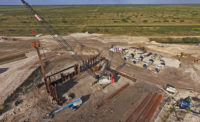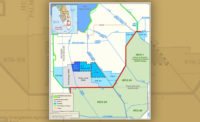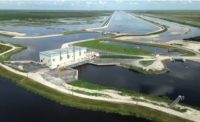One of the largest projects in the Comprehensive Everglades Restoration Plan is currently under construction and on schedule for completion by the end of 2023. The 170,000-acre-ft West Basin Storage Reservoir is taking form on the south bank of the Caloosahatchee River in Hendry County, about five miles southwest of LaBelle, Fla. At completion, its total cost is expected to be $640 million.
The completed reservoir will capture excess stormwater runoff from the C-43 basin and contaminated water discharged from Lake Okeechobee. The impounded water will be used to irrigate adjacent agricultural areas or will be released to the river in a fashion that will maintain proper salinity levels in the Caloosahatchee Estuary.
The estuary is a transition zone where freshwater and seawater meet. Historically, before the Caloosahatchee was connected to Lake Okeechobee to provide an outlet, the salinity level slowly fluctuated in the estuary, supporting a rich ecosystem that adapted to the conditions as the waters mixed gradually with the seasonal flows of the river. But the balance is delicate, perennially threatened by the need to maintain the lake’s elevation so as to protect the dike that surrounds it.
In 2018, heavy rainfall overwhelmed Everglades infrastructure and raised Okeechobee’s elevation, forcing the operators to discharge lakewater laden with agricultural runoff into the river. The polluted freshwater surge altered the estuary’s salinity, damaging the ecosystem and the seafood industry that depends on it. The resulting toxic algal blooms also fouled 145 miles of Florida’s coast, killing wildlife, driving away vacationers and local beachgoers and threatening public health. The public demand for control of the situation has grown.
The C-43 Reservoir is a component of the Comprehensive Everglades Restoration Plan (CERP), launched in 2001 and jointly funded by the federal government and the state of Florida through the U.S. Army Corps of Engineers and the South Florida Water Management District. For the C-43 Reservoir, SFWMD is the “agency responsible for solicitation and management of the construction contract,” says Tom McKernan, the district’s principal construction manager.
“USACE provides engineering support during design and construction as well as construction quality assurance oversight on site to ensure the project meets federal standards,” adds Allison Joura, Corps project manager.
Following design by Carollo Engineers, Blue Goose Construction began preloading and demolition work on 10,500 acres of former citrus farmland in November 2015 under an $11-million contract.
Subsequently, contracts totaling $21 million more were awarded to Enviro-Tech Systems Inc. for site clearing and a QA laboratory; to Loren Jock Trucking Inc. for access roads; and to Harry Pepper & Associates for the S-476 Irrigation Pump Station, a 195-cfs station to provide water to adjacent agricultural areas. The work includes erection of a 300-ft microwave tower for remote operation of the pump stations and gate structures. All were lump-sum contracts, awarded to the lowest responsible and responsive bidder and completed on schedule and budget. The S-476 irrigation station was completed in April 2019.
Two major contracts in the series, an inflow pump station and the Civil Works, remain to be completed. Harry Pepper & Associates received notice to proceed on the 1500-cfs inflow station designated the S-470 in March 2018. That station was 70% complete on Feb. 28 and is scheduled for completion in May 2022.
SFWMD’s Largest-Ever Contract
Easily the largest project underway is the civil works contract, which was awarded in 2019 to C-43 Water Management Builders JV, a joint venture of Lane Construction Corp. and Salini Impregilo. The $524-million contract was the largest ever awarded by SFWMD.
The notice to proceed on the reservoir was issued in June 2019, and construction is on a massive scale. A work force of 450 that includes staff, craftworkers and subcontractors has worked approximately 750,000 work hours to date, managing and operating about 300 pieces of earthwork and other equipment in service of constructing an earthen dam 19 miles long, 28-38 ft high, with a crest measuring 14 ft wide.
“Labor resources have been a challenge, especially during COVID-19,” says Massimo Bugliosi, Lane’s project director. “We can say now that [because] the COVID-19 situation is seemingly improving day by day, there has been some relief.”
“Labor resources have been a challenge, especially during COVID-19.”
—Massimo Bugliosi, Project Director, Lane Construction
Importantly, the new structure will enclose two cells separated by a 2.8-mile-long dam to reduce wave fetch in water 15-25 ft deep. The embankment’s 16 million cu yd of earthen fill will be compacted around 4 million sq ft of soil bentonite cutoff wall.
In the reservoir’s footprint, a layer of relatively clean sand near the surface is underlain by silty or clayey sand and a formation of silty, weathered limestone, McKernan says. “While site conditions were mostly consistent with those anticipated at bid time, there have been a couple of instances where different site conditions were encountered,” Bugliosi says. “We have dealt with those according to the contract and finding a proper agreement with the client.”
During the preloading and demolition contract, which marked the project’s earliest sitework, Blue Goose constructed earthen preload mounds containing monitoring equipment at seven locations inside the dam footprint where water control structures, used to control the inflow and outflow of water in the reservoir, were to be located.
Containing about 285,000 cu yd each of piled soil, the mounds were designed to remove the majority of the settlement potential before the structures were built, McKernan says. On Feb. 28, this project was at 20% completion.
“We are targeting to begin filling the reservoir by the end of 2023,” he adds.
The JV’s bid in 2019 was 21% below the engineer’s estimate and significantly lower than the second lowest of four bidders, but a day-long bid confirmation meeting satisfied the water management district that the bid was valid. “To date there have been no issues related to the estimate,” Bugliosi says.
Expanded Restoration Plan
When Congress approved CERP in 2000, it was envisioned as a 30-year plan that would cost $8.2 billion in 2000 dollars. Today, CERP completion is projected to occur sometime past 2050, says Howard Gonzales Jr., ecosystems branch chief in the USACE Jacksonville, Fla., district, and the 2020 federal report to Congress estimates the total cost for CERP at $23.2 billion in 2019 dollars.
Given the political changes since 2000 and the evolving conditions—including climate change, sea-level rise, invasive species—the overstretched schedule and ballooning cost, while disturbing, are not surprising.
“The implementation plan for CERP ... is based on priority and funding at both the federal and state level,” and priorities “evolve over time,” Gonzales notes. For the C-43 Reservoir alone, the Corps estimates a total cost of $1.03 billion, encompassing both federal and state obligations.
“Climate change is required to be considered in all USACE projects,” Joura adds. For CERP projects specifically, potential impacts from future sea-level change and the trends and projected future for hydrology are two main assessments that are applied, Gonzales adds.
Large, complex and costly construction projects almost always attract opposition, but “we are not aware of any opposition to the C-43 [West Basin Storage Reservoir] Project,” Joura says. Bugliosi concurs. “Everywhere else in the world, we usually face several opposition groups in the place we have to perform any hydro or water work,” he says. “Here, the CERP is welcomed by everybody, as it will improve the quality of water and life of the citizens. We are considered an integral part of the solution rather than a problem.”
John Cassani, retired freshwater ecologist and a staff member of the nonprofit organization Calusa Waterkeeper, says his “general sense” of public opinion is “acceptance that the reservoir will be progress.” Concern about water quality is greater now than it was in the early 2000s, he says, and he believes the estuary requires 450,000 acre-ft annually instead of the reservoir’s 170,000. But he says the reservoir’s designed capacity will prevent significant harm from water flows in the dry season.
Still, some environmentalists have criticized the project because it will not be paired with a stormwater treatment area, an artificial wetland that cleanses water naturally after discharge from the reservoir, as has been done with other Everglades reservoirs. The fear is that the reservoir may just replicate the conditions in Okeechobee and that the reservoir’s discharge will be little better than the lake’s.
The district is aware of this concern and is holding public meetings to address it. Participants in the meetings include environmentalists, elected officials, scientists and local stakeholders. They are examining alternatives but have not yet settled on one. When the reservoir is substantially complete in December 2023, the water quality component will be available, says Randy Smith, SFWMD spokesman.
“There will be a water quality component in the reservoir,” Smith says. “It’s going to accomplish the solution.”










